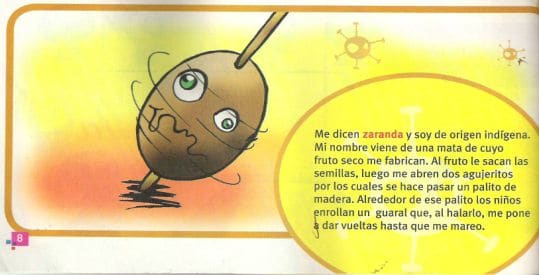
At Venezuelan plain (central plain) the game is played the sieve, native to native indians (guaiqueríes, guamonteyes, arahuacos, tamotes, tamanacos, caribes, palenques, among others), in this area it is played mainly at the time of Holy Week or holy days. Its name comes from a bush of whose dried fruit they make it.
La zaranda is made with a totuma (bowl that is obtained by chopping a large hollow seed into two parts) that is pierced by a stick. In the upper part of the stick, a string is wound which, when pulled, rotates the sieve. Holes are opened to this totuma so that when it is thrown or turned, it penetrates the air and produces the characteristic sound.
To throw or dance the sieve, a cabuya on the stick and then it is pulled to turn it on the ground. Generally, the woman who dances the screen is the woman, since in the Venezuelan plains the man dances the top, in fact the way to play with the screen is that the women are placed in circles and dance their screen and the men throw their tops to destroy the sieve.
Another variant is in times of the Saint's wakes, which are religious rituals that are customarily performed on the occasion of thanking favors or miracles that have been done to a loved one. In this ritual the women throw and dance their sieves and the man throws his top to hit the sieve of the woman he likes, if he destroys it the woman will be his girlfriend for that night.
Another variant of the game is that 6 to 10 women are grouped together with the same number of men, they throw their sieves and the tops, if there are undestroyed sieves, the women win and if they are destroyed, all the men win.
You have a belief that when the children play the screen and it breaks, it is a bad omen, and indicates that something bad is going to happen and they vote the screen.
On the other hand, there were challenges of screening, among players passionate about Venezuelan popular sport. But how was the sieve danced? Well, by means of a strong rope or guaral, to which a crossbar of a stick was placed at the end in the operator's hand, the guaral was wound around the body of the sieve and, by means of a templon, the dancer was released to the ground, where it was shaking, making a sound like that of a giant cigar, flying around the earth.
Preserving traditions is part of our ancestors
worst picture eat ass